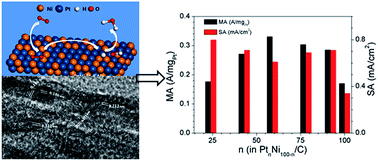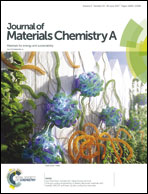Platinum–nickel nanowire catalysts with composition-tunable alloying and faceting for the oxygen reduction reaction†
Abstract
The ability to tune the alloying properties and faceting characteristics of bimetallic nanocatalysts is essential for designing catalysts with enhanced activity and stability through optimizing strain and ligand effects, which is an important frontier for designing advanced materials as catalysts for fuel cell applications. This report describes composition-controlled alloying and faceting of platinum–nickel nanowires (PtNi NWs) for the electrocatalytic oxygen reduction reaction. The PtNi NWs are synthesized by a surfactant-free method and are shown to display bundled morphologies of nano-tetrahedra or nanowires, featuring an ultrathin and irregular helix morphology with composition-tunable facets. Using high-energy synchrotron X-ray diffraction coupled with atomic pair distribution function analysis, lattice expansion and shrinking are revealed, with the Pt : Ni ratio of ∼3 : 2 exhibiting a clear expansion, which coincides with the maximum electrocatalytic activity for the ORR. In comparison with PtNi nanoparticles (NPs), the PtNi NWs display remarkably higher electrocatalytic activity and stability as a result of the composition-dependent atomic-scale alloying and faceting, demonstrating a new pathway to the design of alloy nanocatalysts with enhanced activity and durability for fuel cells.



 Please wait while we load your content...
Please wait while we load your content...